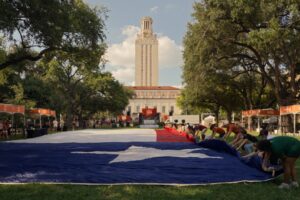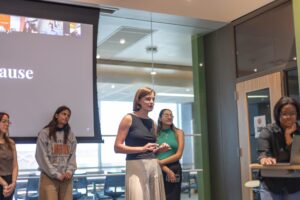AUSTIN, Texas—The University of Texas at Austin Center for Computational Visualization (CCV) and Compaq Computer Corp. (NYSE: CPQ) have entered into a cooperative research relationship in advanced visualization techniques, using high-performance computers and complex display equipment.
Researchers can use the new tools to simulate events that take place at very large scales such as the explosion of a star, the motion of galaxies or what might happen if black holes collide. They also can simulate extremely small-scale events at the subatomic scale. Computerized images such as strata underneath the earth’s surface can be used to predict the production of oil reserves and the human body can be examined layer by layer or cell by cell.
“Simulation technology allows you to manipulate the scales of time,” explained Dr. J. Tinsley Oden, director of UT Austin’s Texas Institute for Computational and Applied Mathematics (TICAM). Oden is the Cockrell Family Regents Chair in Engineering (No. 2). “You can look at events that take place over thousands of years. You can look at events that may take place a thousand years in the future. You can study events that take place in a microsecond. In essence, you slow down time, or you speed it up — whatever is necessary to model and study the phenomena of interest.”
Testing complex theories in geophysics, astronomy, medicine and other scientific disciplines produces such large amounts of data that scientists often find it difficult to see the solution. “That’s where visualization is of enormous benefit,” Oden said. “It becomes the indispensable tool in interpreting results and making sense out of these calculations.”
“Imagine being flown around the Grand Canyon, experiencing its expanse and magnificence, and having that combined with the additional ability to ask for a closer look or increased lighting at certain choice scenic spots while this is instantaneously displayed with stunning detail on a big wall,” said Dr. Chandrajit L. Bajaj, director of the CCV and holder of the CAM Chair in Visualization. “That is one example of the potential this technology promises.”
Examples can be seen at: www.ticam.utexas.edu/ccv
Powering the lab’s extensive computer processing requirements is a cluster of Compaq SP750 workstations. The 130 workstations and disk drives are networked using Compaq ServerNet II high-speed, low-latency interconnect technology.
“UT Austin chose Compaq because Compaq is continually developing state-of-the art networking and data storage technology in addition to faster computers,” said Bajaj. “Compaq’s research and development of all facets of computing technology mirrors UT Austin’s roles in computational research and education.”
Mike Humke, Compaq director of higher education, said: “Compaq’s collaboration with the UT Austin CCV is enabling pioneering visualization research that promises to touch many lives. We foresee this leading to noninvasive diagnostic medical tests. Manufacturers may use it to create new substances that are lighter or safer or stronger. The possibilities are endless.”
“This is a showplace for the innovation that can result when inspired minds are freed by Compaq technology,” Humke said. “We are understandably proud of the fact that Compaq’s leading industry-standard clustering and computing technologies are helping to create a new generation of application development around advanced visualization.”
With the PC cluster, high-speed networking and graphic capabilities provided by Compaq, the UT Austin CCV lab will become the leader among high-performance facilities at universities, Bajaj said. He said the relationship with Compaq would help maintain the CCV’s position “on the leading edge of visualization, not only in the United States, but also in the world. The CCV lab is by far the premier place for research and graduate study in the visualization sciences.”
The CCV is a cross-disciplinary effort overseen by UT Austin’s Texas Institute of Computational and Applied Mathematics (TICAM) and the department of computer sciences in the College of Natural Sciences. The CCV collaborates on research projects with the high-tech industry, national research labs and computational scientists and engineers at UT Austin’s TICAM.
For more information, contact Dr. Chandrajit Bajaj, director of the Center for Computation Visualization (CCV) at (512) 471-8870, e-mail: bajaj@cs.utexas.edu or see: www.ticam.utexas.edu/ccv
Contact Compaq Computer’s Barbara Crystal at (218) 514-9809 or e-mail: barbara.crystal@compaq.com, or Melissa Cox at (972) 776-5027 or e-mail: < melissa.cox@compaq.com
For images, see: www.utexas.edu/admin/opa/news/01newsreleases/nr_200103/compaq2.html
The Compaq Web site is: www.compaq.com



